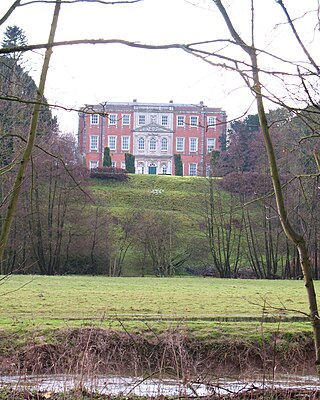
Shugborough Hall is a stately home near Great Haywood, Staffordshire, England.

Kingston Lacy is a country house and estate near Wimborne Minster, Dorset, England. It was for many years the family seat of the Bankes family who lived nearby at Corfe Castle until its destruction in the English Civil War after its incumbent owners, Sir John Bankes and Dame Mary, had remained loyal to Charles I.
Baron Ravensworth, of Ravensworth Castle in the County Palatine of Durham and of Eslington Park in the County of Northumberland, is a title in the Peerage of the United Kingdom.

Scampston Hall is a Grade II* listed country house in North Yorkshire, England, with a serpentine park designed by Charles Bridgeman and Capability Brown. It is located on the north side of the A64 Leeds/Scarborough road, 4 miles (6 km) east of Malton, in Scampston village. The name of the village was referred to in various ways in ancient documents as: Scamestun, Skameston, Skameston, and Skampston, and was probably derived from a personal name.

West Ham Park is a privately owned public park in West Ham in the London Borough of Newham. Spanning 77 acres (31 ha), it is the largest park in the borough. The park has been managed by the City of London Corporation since 1874.

Barham is a village and civil parish in the City of Canterbury district of Kent, England. Barham village is approximately 6 miles (10 km) south-east from Canterbury and 8 miles (13 km) north from Folkestone.

Sudbury is a suburb in the London Borough of Brent, located in northwest London, United Kingdom. The suburb forms the western part of Wembley and is centred around 0.6 miles (1 km) west of Wembley Central railway station.

Rolvenden is a village and civil parish in the Ashford District of Kent, England. The village is centred on the A28 Ashford to Hastings road, 5 miles (8.0 km) south-west of Tenterden.

Aldby Park is a country estate in the village of Buttercrambe near the village of Stamford Bridge in the East Riding of Yorkshire, England.

(New) Hawarden Castle is a house in Hawarden, Flintshire, Wales. It was the estate of the former British prime minister William Gladstone, having previously belonged to the family of his wife, Catherine Glynne. Built in the mid-18th century, it was later enlarged and externally remodelled in the Gothic taste.

Great Maytham Hall, near Rolvenden, Kent, England, is a Grade II* listed country house. The gardens are famous for providing the inspiration for The Secret Garden by Frances Hodgson Burnett.

Sudbourne is a village and civil parish in Suffolk, England, located approximately 2 miles (3 km) north of Orford.

Lambert Tree was a United States state court judge, ambassador, and patron of the arts.
Marbury Hall was a country house in Marbury, near Northwich, Cheshire, England. Several houses existed on the site from the 13th century, which formed the seat successively of the Marbury, Barry and Smith-Barry families, until 1932. An extensive collection of artwork and sculpture was housed at the hall from 1801 until the 1930s. The final house was extensively remodelled by Anthony Salvin in the 1850s.
Raikes Currie was Member of Parliament (MP) for Northampton from 1837 to 1857. He was a partner of the bank Curries & Co., which became part of Glyn, Mills & Co. in 1864, along with his father, Isaac Currie, in Cornhill, City of London, and had several interests in the newly developing colony of South Australia. He restored Minley Manor and made substantial improvements to the estate, work which was continued by his son and grandson.

Browsholme Hall is a privately owned Tudor house in the parish of Bowland Forest Low in the borough of Ribble Valley, Lancashire, England. It is claimed to be the oldest surviving family home in Lancashire. Since 1954, it has been designated a Grade I listed building by English Heritage.
Sir George Barham was an English businessman and founder of the Express County Milk Company, later to become Express Dairies. He is sometimes described as the father of the British dairying industry.

Rudding Park Hotel, Spa and Golf is a Grade I listed Regency-style country house in Harrogate, North Yorkshire, England.

Plympton House is the principal residence at the Plympton House Estate, in the parish of Plympton St Maurice, Devon, England. It is a Grade I listed country house, in the William and Mary tradition, near St Maurice's Church in Plympton, commenced by Sir George Treby (1643–1700) and completed c. 1715 – 1720 by his son George Treby. The architect is unknown although accounts in 1720 refer to William Veale, mason. Its kitchen garden wall, southern boundary walls and gate piers and walls are Grade II listed.

Boynton Hall is a country house in the village of Boynton near Bridlington, East Riding of Yorkshire, England. It is a Grade I listed building.


















